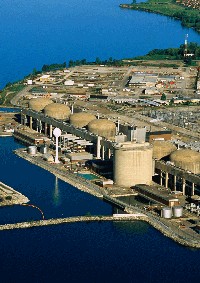 |
Protecting Canadians'
Health
Increased demand and the development of new technologies in the fields
of nuclear medicine and radiation therapy require constant vigilance on
the part of the Canadian Nuclear Safety Commission. |
| |
Protecting Canadians'
Safety
The CNSC's regulatory regime requires that licensees
design, construct and operate their facilities safely at all times. |
 |
| |
 |
Protecting Canadians'
Security
To protect Canadians, the CNSC has initiated major new security
initiatives that apply to nuclear facilities and substances. |
| |
Protecting the Canadian
Environment
Protecting the environment is of major importance in the
work of the CNSC, through its environmental responsibilities under the
Nuclear Safety and Control Act and other relevant legislation. |
 |
Section I - Overview
Message from the President and Chief Executive Officer
 I am pleased to present the 2004-2005 Performance Report of the Canadian Nuclear
Safety Commission (CNSC).
I am pleased to present the 2004-2005 Performance Report of the Canadian Nuclear
Safety Commission (CNSC).
This report covers my fourth year as President and Chief Executive Officer of
the CNSC. It outlines the important steps that the CNSC, as Canada’s nuclear
regulator, has taken over the past year to deliver on its mission to protect
health, safety, security and the environment and to respect Canada's
international commitments on the peaceful use of nuclear energy.
On behalf of Canadians, the CNSC continues to exercise effective regulatory
control over the use of nuclear energy and materials. In addition to our vital
work in licensing and in compliance inspection, we are continuing to improve our
robust regulatory framework. In addition, we have launched the Power Reactor
Regulation Improvement Program, which is intended to ensure that the power
reactor regulation program delivers more effective regulatory oversight. The
CNSC has made substantial progress on the documentation of an updated licensing
basis for the design of power reactors. This draft CNSC standard will be used to
assess the licensability of any new reactors in Canada. The CNSC is committed to
the implementation of quality management practices. We have already introduced
an integrated management system to define and apply a common set of management
practices and principles, align current and future improvements, and link key
activity areas to outcomes.
The Commission Tribunal operates separately from CNSC staff, setting
regulatory policy directions on matters relating to health, safety, security and
environmental issues affecting the Canadian nuclear industry. It establishes
legally-binding regulations and makes independent decisions on the licensing of
nuclear-related activities in Canada. During the reporting year, the Commission
held more than fifteen public hearings involving significant nuclear facility
licensing decisions and during which the Commission heard from intervenors, in
some cases, in large numbers. Decisions were rendered on these applications
based on the need to protect the health, safety, and security of Canadians and
the environment.
The CNSC has also been active in efforts to ensure Canadian application of
international standards and practices for the safe and peaceful use of nuclear
energy. International highlights of the past year include: adopting an
internationally harmonized regulatory regime for radioactive sources thereby
enhancing regulatory oversight on the tracking and movement of radioactive
sources within Canada and internationally; initiating an international peer
review of Canada’s power reactor regulatory program; strengthening
international guidelines governing the safe operation of research reactors
worldwide; strengthening radiation protection requirements for carriers; and
reviewing the International Atomic Energy Agency's (IAEA) safeguards system to
assess its efficiency and effectiveness.
The CNSC also launched a values and ethics program in March 2005, under the
theme “ Helping good people do the right thing ”. This is a key
component of a sound governance structure. A clearly articulated values and
ethics strategy will provide CNSC staff with practical tools to guide them in
making ethical decisions in the course of their work, and will also strengthen
the CNSC’s relationships with licensees and stakeholders. The CNSC’s Audit
and Ethics Group continues to be responsible for performing a rigorous internal
audit role and, new in 2005, for receiving and investigating disclosures of
wrongdoing consistent with the draft Public Servants Disclosure Protection
Act (Bill C-11).
As you will see in the following pages, the CNSC has made important strides
in every area of its mandate. Although many challenges lie ahead, our
accomplishments so far provide a solid foundation on which to build.
As we move forward, our commitment to the people of Canada will remain
unwavering – to protect health, safety, security and the environment and to
respect Canada’s international commitments on the peaceful use of nuclear
energy. Whatever new growth or demands we face, we will not lose sight of this
mission.
Sincerely,
The paper version was signed by
Linda J. Keen, M.Sc.
Management Representation Statement
I submit for tabling in Parliament, the 2004-05 Departmental Performance
Report (DPR) for the Canadian Nuclear Safety Commission.
This document has been prepared based on the reporting principles contained
in the Treasury Board of Canada Secretariat’s Guide for the preparation of
2004-05 Departmental Performance Reports :
- It adheres to the specific reporting requirements;
- It uses an approved Program Activity Architecture;
- It presents consistent, comprehensive, balanced and accurate information;
- It provides a basis of accountability for the results pursued or achieved
with the resources and authorities entrusted to it; and
- It reports finances based on approved numbers from the Estimates and the
Public Accounts of Canada.
The paper version was signed by
Linda J. Keen, M.Sc.
President and Chief Executive Officer
August 19, 2005
|
